What is the flex screen in basketball
The flex screen in basketball consists of action that occurs when one particular offensive player cuts toward the general area of the court that is between the low post block and the adjacent corner while facing the sideline to set a screen for a second offensive player who occupies that same corner.
Afterwards, the second offensive player in the corner could cut to the basket via the flex screen, receive the ball from a third offensive player, and score at the rim with a layup or dunk.
Additionally, the flex screen is a fundamental element within the Flex offense, which also typically includes the down screen, another notable type of basketball screen as well as continuity patterns.
Furthermore, the flex screen is an off-ball screen because it is designed to help an offensive player without possession of the ball get open for a possible scoring opportunity.
Moreover, the flex screen is also a type of back screen because it is set behind a defender, which could be difficult for a targeted defender to fully avoid, especially without verbal communication from at least one other defender.
Why is the flex screen potentially effective
The flex screen is potentially effective because it could possibly lead to high percentage scoring opportunities at the basket and it could also be utilized with other screening actions to produce multiple scoring options.
Possibly lead to high percentage scoring opportunities
The flex screen could possibly lead to high percentage scoring opportunities primarily because of the screening action that occurs near the basket as well as the cutting action of the offensive player that would use the flex screen.
Basically, if an offensive player is able to get open when cutting to the basket via the flex screen, then that could result in a layup or dunk at the rim, which are essentially the highest percentage shot attempts in the game of basketball.
Additionally, if an offensive player cuts to the basket via the flex screen but a layup or dunk is not available, then that same offensive player could potentially execute low post moves around the basket, which could also be high percentage shot attempts as well.
Could be utilized with other screening actions
The flex screen could be also utilized with other screening actions to create multiple scoring options near the basket and/or near the perimeter areas of the court.
For example, within the basic Flex offense, once an offensive player sets the flex screen, that same offensive player would then usually cut to the perimeter by way of a down screen, which is also screen the screener action.
As a result, the offensive team is able to create a few probable scoring options; a layup, dunk, or low post move near the basket as well as a possible mid-range or three-point jump shot near the perimeter areas of the court.
What are examples of basketball plays that include the flex screen
Example 1
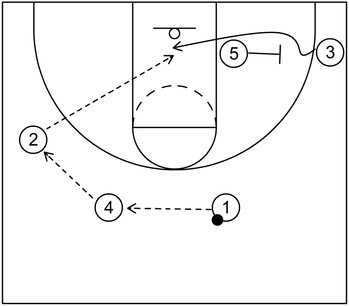
This is an example of a very simple basketball play that features the flex screen to create a quick hitting scoring opportunity near the basket.
To start, 4 receives the ball from 1 and then, 2 receives the ball from 4. Following that, 3 cuts to the basket via the flex screen set by 5, receives the ball from 2, and scores near the basket.
Example 2 – Part 1
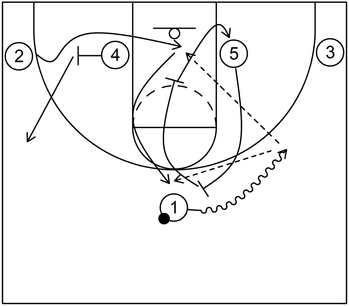
This is an example of a basic basketball play initiated from the 1-4 low alignment that consists of the flex screen and scoring options near the rim or near the perimeter. To begin, 1 dribbles toward the right side wing via the on-ball screen set by 5.
As that happens, 2 cuts to the basket via the flex screen set by 4. Afterwards, 2 could receive the ball from 1 and score near the rim if that is open.
If 2 is not open near the basket, then 2 could cut to the top via the down screen set by 5. From there, 2 could receive the ball from 1 and take the three-point jump shot if open.
If 2 receives the ball but is not open to take the shot, then 4 could pop out to the left side wing and 5 could self-replace near the right side low post block.
Example 2 – Part 2
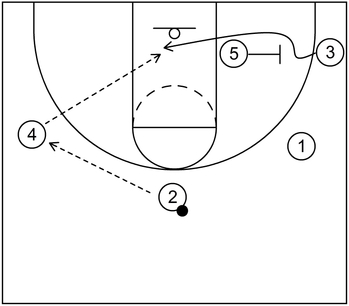
Next, 4 could receive the ball from 2 and after that, 3 could cut to the basket via the flex screen set by 5. From that point , 3 could receive the ball from 4 and score near the rim.
Example 3 – Part 1
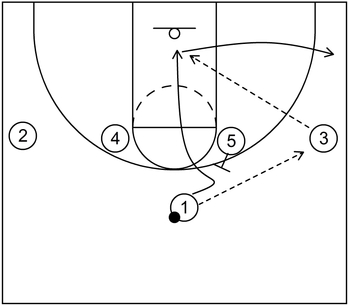
This is an example of a basic basketball play that features flex action initiated from a 1-4 high alignment.
To start, 3 receives the ball from 1 and then, 1 cuts to the basket via the UCLA screen set by 5. From that action, 1 could receive the ball from 3 if that is open. Otherwise, 1 could cut through to the right side corner.
Example 3 – Part 2
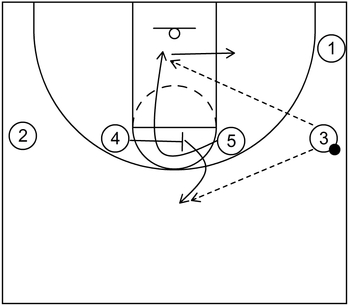
Next, 5 could execute a curl cut towards the basket by way of the cross screen set by 4 near the high post area. Following that, 5 could receive the ball from 3 and score near the rim.
If that is not available, then 5 could fill the right side low post block while 4 pops out to the top and receives the ball from 3.
Example 3 – Part 3
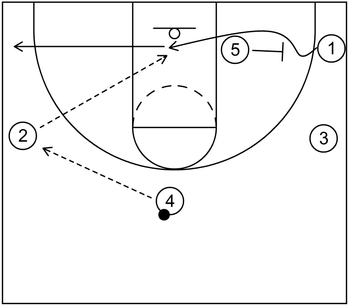
From there, 2 receives the ball from 4 and afterwards, 1 cuts to the basket via the flex screen set by 5.
Next, 1 receives the ball from 2 and scores around the basket. Alternatively, if 1 does not receive the ball, then 1 could continue through to the left side corner.
Example 3 – Part 4
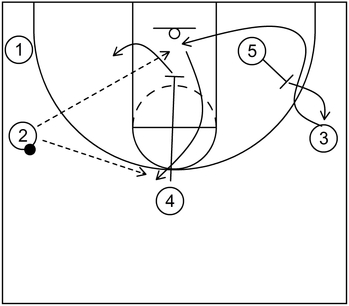
Following that, 3 could cut to the basket via the angled back screen set by 5. Afterwards, 3 could receive the ball from 2 and score near the basket.
If 3 does not receive the ball near the basket, then, 3 could cut to the top via the down screen set by 4. From that point, 3 could receive the ball from 2 and take the three-point jump shot if open.
Also, if 3 receives the ball but does not take the jump shot, then 4 could fill the left side low post block while 5 fills the right side wing area.
Example 3 – Part 5
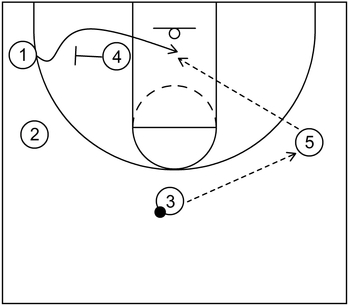
Next, 5 could receive the ball from 3 and after that, 1 could cut to the basket via the flex screen set by 4. Following that action, 1 could receive the ball from 5 and score around the rim, particularly with a layup.